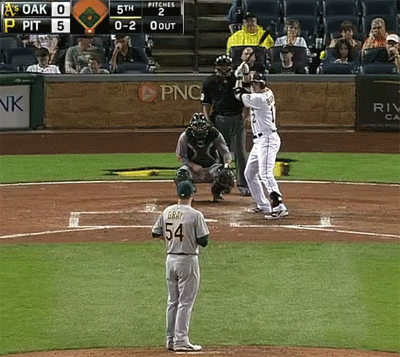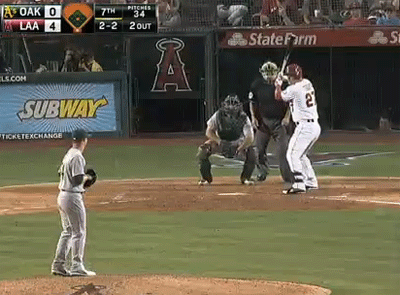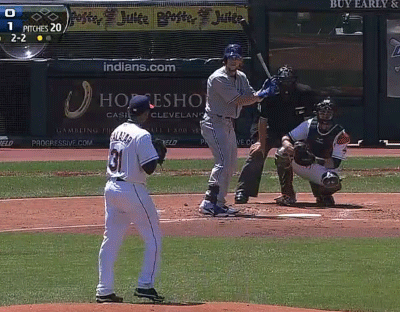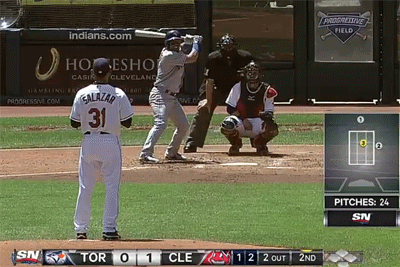In the week leading up the All-Star break, a trio of American League pitchers made their respective MLB debuts. The rookies were summoned from the minors in a span of three consecutive days and immediately sent into action, only to have each of their tours cut short with a return trip to the bush leagues. The call-ups were well-covered by my BP colleagues, and though the sips of coffee were brief, you can bet that the memories from their first taste of the majors will last a lifetime. Let’s take a mechanical look at what we can expect when this trio returns.
July 10 – Sonny Gray, Oakland at Pittsburgh
The A's tabbed the Vanderbilt product with their first pick in the 2011 draft (no. 18 overall). He was promoted aggressively, receiving an assignment to double-A Midland within two months of being drafted and after just two innings of rookie ball. The numbers from his first full season were less than inspiring, but he has rebounded this season with a sub-3.00 ERA and more than a strikeout per inning in over 100 frames for triple-A Sacramento. The All-Star break precluded the need for a fifth starter in the Oakland rotation, so the A's called up Gray to pitch out of the bullpen while Dan Straily stayed on turn with the River Cats.
Gray was promoted on July 10th and made his major-league debut that same evening in an interleague match-up with the surging Pirates. He spun two clean frames in a game that Oakland was trailing by five runs, which helped to eat some innings after starter Tommy Milone had exited in the third. Gray struck out three of the seven batters he faced, including this swinging K of Clint Barmes on a wicked breaking ball for the right-hander's first big-league punchout.

Gray brings legit power from his sub-six-foot frame, averaging 95-mph during his stint out of the Oakland bullpen. With two plus pitches, he can be a relief asset to the A's right away, though his ultimate role could be determined by his development of the changeup. The A's have every intention of letting him stick in the rotation, so Gray was re-exchanged for Straily on July 19 in order to return to his regularly-scheduled regimen of frustrating Pacific Coast League batters six innings at a time. He finished his initial stint in the show with zero runs and just three baserunners allowed over four innings of mop-up duty, including six strikeouts and a single walk.
Mechanics Report Card
|
Balance |
50 |
|
Momentum |
60 |
|
Torque |
65 |
|
Posture |
45 |
|
Release Distance |
55 |
|
Repetition |
N/A |
For an explanation of the grading system for pitching mechanics, please consult this pair of articles.
Gray stands out among the pitchers in the Oakland organization with his high-energy mechanics as well as his relative instability during the delivery. His torque is even bigger than the radar gun suggests, with tremendous hip-shoulder separation that comes from a big upper-body twist in conjunction with a strong delay of trunk rotation—his belt buckle is nearly facing the plate before the shoulder-axis fires. Gray also carries plus momentum in his arsenal of power mechanics, with a strong early move toward the plate as well as an explosive second gear. Some evaluators might see the slight frame and the electric stuff as harbingers of future bullpen duty, but while Gray's first two MLB appearances were in relief, they were preceded by starts in his first 50 pro games.

The prototypical Athletics pitcher might be lighter on the power grades but make up the difference with outstanding marks in balance, posture, and repetition of mechanical timing. Gray is an anomaly in this regard, as his balance is disrupted mid-delivery by a vicious drop-and-drive after leg lift, and the instability carries a ripple effect of sub-average posture at release point. It is common for pitchers with big momentum and heavy torque to struggle with harnessing such high levels of kinetic energy, and though his MLB sample was too small to warrant a grade for repetition, I can imagine that Gray occasionally battles to find his timing pattern. He is in a great organization to hone his craft on the mound, and the blend of raw stuff and mechanical fortitude are positive signs for his future.
July 11 – Danny Salazar, Cleveland vs Toronto
Salazar ranked sixth on BP's pre-season prospect list for Cleveland with a scouting report that is eerily reminiscent of Sonny Gray's profile, though Salazar's injury history further clouds his future role. At an even six feet, Salazar lacks the size of a prototypical ace, but he cooks with serious gas that ran as high as 99.8 mph in his debut against the Blue Jays two weeks ago. The 58 fastballs he threw averaged better than 96 mph on the gun, and he mixed in some late-diving breaking balls with heavy vertical movement that he could bury under the zone at 83-89 mph.

Salazar has posted low walk rates for the past three seasons in the minors, and he has upped the strikeout ante in 2013 with 110 K's in just 83 innings of work on the farm. He owned the Blue Jays in his debut, striking out seven batters against one walk and two hits across six innings and yielding a single run on Jose Bautista's RBI double to the left-field corner. The Indians won, but Salazar was shipped back to Columbus the following day, where he’s waiting for Cleveland to give him another shot.
Mechanics Report Card
|
Balance |
60 |
|
Momentum |
55 |
|
Torque |
65 |
|
Posture |
50 |
|
Release Distance |
50 |
|
Repetition |
45 |
The Gray similarities extend to Salazar's mechanics report card, which features a list of strengths and weaknesses comparable to that of the Oakland right-hander. Power is Salazar's greatest asset, with above-average momentum and the heavy torque to tease 100 mph. His hip-shoulder separation is maximized with additional upper-body load as well as his delayed trigger of trunk rotation; however, he also delays the rotation of his hips until late in the mechanical sequence, and this late hip-rotation narrows the time window that Salazar has to execute the rotational phases of the delivery.

Salazar had very inconsistent timing and sequencing of his mechanics in the Toronto game, due to variations in momentum as well as trouble with lining up the gears of rotation. The game stats are somewhat deceiving, as there were several instances where Salazar got away with pitches that badly missed targets. His stuff had the bite to survive despite the lack of pitch command, and he may have been battling some debut jitters, but the mechanical indicators suggest that Salazar will need to fine-tune his delivery if he is to find consistent success in the majors.
July 12 – Jarred Cosart, Houston @ Tampa Bay
Cosart, a minor-league veteran of five seasons, joined the Astros organization in the 2011 trade that brought Hunter Pence to Philadelphia. He has steadily climbed the ladder and entered this season as the fifth-ranked prospect in the Houston system, with a repertoire cut from the same mold as his two predecessors on this list, including big velocity and a plus breaking ball with relatively little in the off-speed department. The 'Stros decided it was time to give the kid a shot to prove himself with a promotion just before the All-Star break, and Cosart drew a tough assignment in his debut, facing a Tampa Bay ballclub that had won 12 of its past 13 games (including the last eight in a row).

All he did was take a no-hitter into the seventh inning, as Cosart shut out the Rays for eight frames before the bullpen took over and the Astros were able to lock down the unlikely victory. Cosart was able to defeat 2012 Cy winner David Price at the Trop, where the Rays have a 34-19 record that ties them with Boston for the best home mark in the game, while Houston's road tally of 16-30 is tied for the second-worst record in baseball.
Cosart registered just a pair of strikeouts against three walks, but he limited the Tampa Bay offense to a pair of harmless singles before giving way to the relief corps in the ninth inning. He averaged 95.3 mph with his heat and popped 97 on his third pitch of the game. It was the hardest throw of the contest for Cosart, who was likely pumping with adrenaline in the first inning, as more than half of his pitches that cleared 96 mph were tossed in that initial frame. The rookie was sent back to Triple-A the following day, but he was recalled on Tuesday to start against the A's.
Mechanics Report Card
|
Balance |
55 |
|
Momentum |
55 |
|
Torque |
60 |
|
Posture |
50 |
|
Release Distance |
50 |
|
Repetition |
40 |
Cosart displays a different balance pattern when pitching from the windup versus the stretch. When the bases are clear, Cosart's head floats around his center-of-mass as he goes through the motions of his full windup; with runners on base, however, he simplifies the delivery and has a much easier time controlling his balance in the process. The net result is above-average balance, but the disparity between wind-up and stretch was just one aspect of his poor mechanical repetition.

Cosart has an interesting technique with his momentum, as he swings his leg toward the plate after the lift phase of his delivery. The strategy adds to his burst of second gear, but he struggles to finish with a consistent stride position, and he ends up with a very closed stride angle that limits his release-point distance. Cosart’s torque has been inconsistent as well—he has the biggest upper-body twist and scapular load of the three debut pitchers, but the odd timing and positioning of his leg-swing confuses the process of rotation. His sequence of hip rotation has two phases: the closed stride minimizes his degree of early hip-rotation into foot strike, and then he whips the hips after cementing his stride position. The technique messed with Cosart’s timing of trunk rotation in his second start, resulting in several missed targets, a factor that might explain his poor walk totals in the minor leagues.
Thank you for reading
This is a free article. If you enjoyed it, consider subscribing to Baseball Prospectus. Subscriptions support ongoing public baseball research and analysis in an increasingly proprietary environment.
Subscribe now